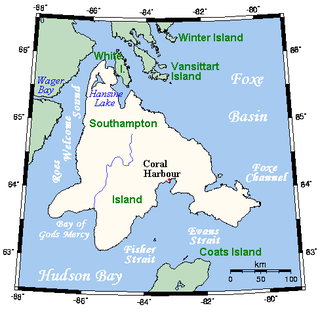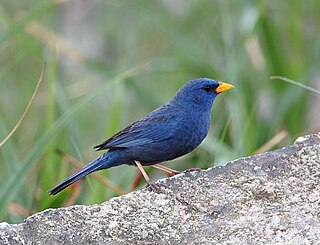
The snow goose is a species of goose native to North America. Both white and dark morphs exist, the latter often known as blue goose. Its name derives from the typically white plumage. The species was previously placed in the genus Chen, but is now typically included in the "gray goose" genus Anser.

Southampton Island is a large island at the entrance to Hudson Bay at Foxe Basin. One of the larger members of the Canadian Arctic Archipelago, Southampton Island is part of the Kivalliq Region in Nunavut, Canada. The area of the island is stated as 41,214 km2 (15,913 sq mi) by Statistics Canada. It is the 34th largest island in the world and Canada's ninth largest island. The only settlement on Southampton Island is Coral Harbour, called Salliq in Inuktitut.

The African rail is a small wetland bird of the rail family.

The crane hawk is a species of bird of prey in the family Accipitridae. It is monotypic within the genus Geranospiza.

The blue korhaan or blue bustard is a species of bird in the family Otididae which is native to South Africa. Its call is a series of frog-like croaks, usually uttered in flight. Its natural habitat is plateau grassland, dry shrubland, arable land and pastureland. Its preferred habitat is one with short grassland and flat topography.

The ashy flycatcher, blue-grey flycatcher or ashy alseonax is a species of bird in the family Muscicapidae. It is found throughout sub-Saharan Africa, excluding the drier areas of South Africa, Botswana, and Namibia. It inhabits subtropical or tropical dry forest, subtropical or tropical moist lowland forest, and savanna. The species does not display sexual dimorphism, with both sexes being grey in colour with pale grey or white underparts. Different subspecies show minute differences in appearance.

The blue finch or yellow-billed blue finch is a species of small bird. Although it was long classified in the bunting family Emberizidae, or the cardinal family Cardinalidae, more recent molecular studies have shown it fits comfortably in the Thraupini tribe within the family Thraupidae.

Psilocybe caerulescens, also known as Landslide mushroom, is a psilocybin mushroom having psilocybin and psilocin as main active compounds. Along with Psilocybe mexicana and Psilocybe aztecorum, it is one of the mushrooms likely to have been used by the Aztecs and is currently used by Mazatec shamans for its entheogenic properties.

The blue-winged grasshopper, Oedipoda caerulescens, is a grasshopper in the genus Oedipoda.

The Sečovlje Saltworks is the largest Slovenian salt evaporation pond. Along with the Strunjan Saltworks, they are the northernmost Mediterranean saltworks and one of the few where salt is still produced in a traditional way, as well as a wetland of international importance and a breeding place for waterbirds. They are part of the Piran Saltworks and are located at Parecag in Slovenian Istria, the southwest of the country, at the Adriatic Sea, along the mouth of the Dragonja River near Sečovlje.

Taphrina caerulescens is a species of fungus in the family Taphrinaceae. It is a pathogenic Ascomycete fungus that causes oak leaf blister disease on various species of oak trees. The associated anamorph species is Lalaria coccinea, described in 1990. This disease causes lesions and blisters on Oak leaves. Effects of the disease are mostly cosmetic. Although not taxonomically defined, strains of T. caerulescens have been shown to be host specific with varying ¬ascus morphology between strains. There are differences in strains’ abilities to metabolize various carbon and nitrogen compounds. This has been proposed as a method of taxonomically defining subspecies within T. caerulescens.

Acacia caerulescens, commonly known as limestone blue wattle, Buchan blue or Buchan blue wattle is a tree species that is endemic to south eastern Australia
Conanthalictus is a genus of sweat bees in the family Halictidae. There are about 13 described species in Conanthalictus.

Nemoria caerulescens is a species of emerald moth in the family Geometridae. It is found in North America.

Speyeria nokomis, the nokomis fritillary, is a species of fritillary in the family of butterflies known as Nymphalidae. It is found in North America.

Senopterina is a genus of signal flies. There are about 17 described species in Senopterina.
Senopterina foxleei is a species of signal flies.
Senopterina varia is a species of signal flies.

The Pennsylvania State Game Lands Number 24 are Pennsylvania State Game Lands in Clarion, and Forest Counties in Pennsylvania in the United States providing hunting, bird watching, and other activities.

The Pennsylvania State Game Lands Number 29 are Pennsylvania State Game Lands in Warren Counties in Pennsylvania in the United States providing hunting, bird watching, and other activities.















